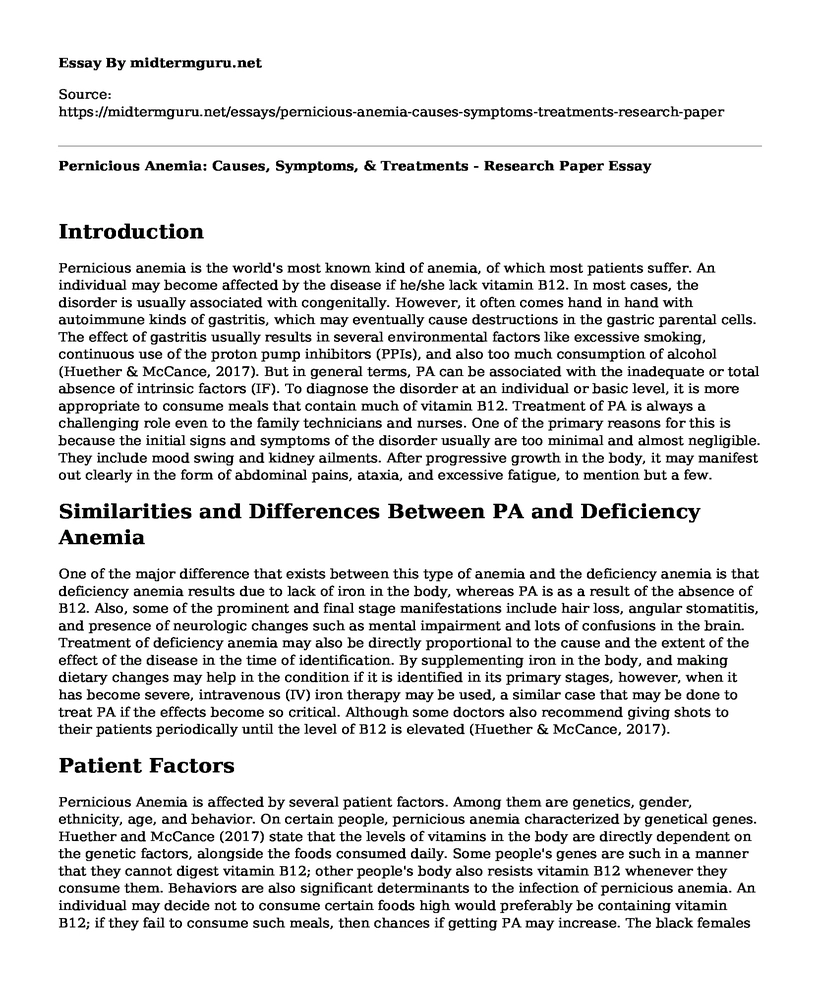Introduction
Pernicious anemia is the world's most known kind of anemia, of which most patients suffer. An individual may become affected by the disease if he/she lack vitamin B12. In most cases, the disorder is usually associated with congenitally. However, it often comes hand in hand with autoimmune kinds of gastritis, which may eventually cause destructions in the gastric parental cells. The effect of gastritis usually results in several environmental factors like excessive smoking, continuous use of the proton pump inhibitors (PPIs), and also too much consumption of alcohol (Huether & McCance, 2017). But in general terms, PA can be associated with the inadequate or total absence of intrinsic factors (IF). To diagnose the disorder at an individual or basic level, it is more appropriate to consume meals that contain much of vitamin B12. Treatment of PA is always a challenging role even to the family technicians and nurses. One of the primary reasons for this is because the initial signs and symptoms of the disorder usually are too minimal and almost negligible. They include mood swing and kidney ailments. After progressive growth in the body, it may manifest out clearly in the form of abdominal pains, ataxia, and excessive fatigue, to mention but a few.
Similarities and Differences Between PA and Deficiency Anemia
One of the major difference that exists between this type of anemia and the deficiency anemia is that deficiency anemia results due to lack of iron in the body, whereas PA is as a result of the absence of B12. Also, some of the prominent and final stage manifestations include hair loss, angular stomatitis, and presence of neurologic changes such as mental impairment and lots of confusions in the brain. Treatment of deficiency anemia may also be directly proportional to the cause and the extent of the effect of the disease in the time of identification. By supplementing iron in the body, and making dietary changes may help in the condition if it is identified in its primary stages, however, when it has become severe, intravenous (IV) iron therapy may be used, a similar case that may be done to treat PA if the effects become so critical. Although some doctors also recommend giving shots to their patients periodically until the level of B12 is elevated (Huether & McCance, 2017).
Patient Factors
Pernicious Anemia is affected by several patient factors. Among them are genetics, gender, ethnicity, age, and behavior. On certain people, pernicious anemia characterized by genetical genes. Huether and McCance (2017) state that the levels of vitamins in the body are directly dependent on the genetic factors, alongside the foods consumed daily. Some people's genes are such in a manner that they cannot digest vitamin B12; other people's body also resists vitamin B12 whenever they consume them. Behaviors are also significant determinants to the infection of pernicious anemia. An individual may decide not to consume certain foods high would preferably be containing vitamin B12; if they fail to consume such meals, then chances if getting PA may increase. The black females are also generally associated with PA than the white females, too, the women who experience much loss of blood I the process of menstruation or birth stand at higher chances of PA (Huether & McCance, 2017).
Concerning age, PA is frequently dominant with the elderly than the younger individuals because, at old ages, one may not be able to have the gastric atrophy which is the major attractive cause of the disorder. However, teenagers and other youths may experience the disease die the difficulty in producing enough intrinsic factors or production of a specific antibody that fights against the intrinsic factors already existing. Finally, it is important to note that, the claim that ethnicity affects PA in any way remains a myth with no proof.
Reference
Huether, S. E., & McCance, K. L. (2017). Understanding pathophysiology (6th ed.). St. Louis, MO: Mosby.
Cite this page
Pernicious Anemia: Causes, Symptoms, & Treatments - Research Paper. (2023, Jan 16). Retrieved from https://midtermguru.com/essays/pernicious-anemia-causes-symptoms-treatments-research-paper
If you are the original author of this essay and no longer wish to have it published on the midtermguru.com website, please click below to request its removal:
- Public Health Paper Example: What Is Alcohol Health?
- The Role of Public Health in Social Care - Essay Sample
- Essay Saple on Organ Selling
- Life-Threatening Disease: Understanding Cystic Fibrosis (CF) - Research Paper
- Acadia Pharmaceuticals: Innovative Treatments for Central Nervous System Disorders - Essay Sample
- Hydration Status: Examining Body Weight & Urine Indices - Research Paper
- Clinician's Unique Skill: Understanding Patient Goals & Prognosis - Essay Sample







